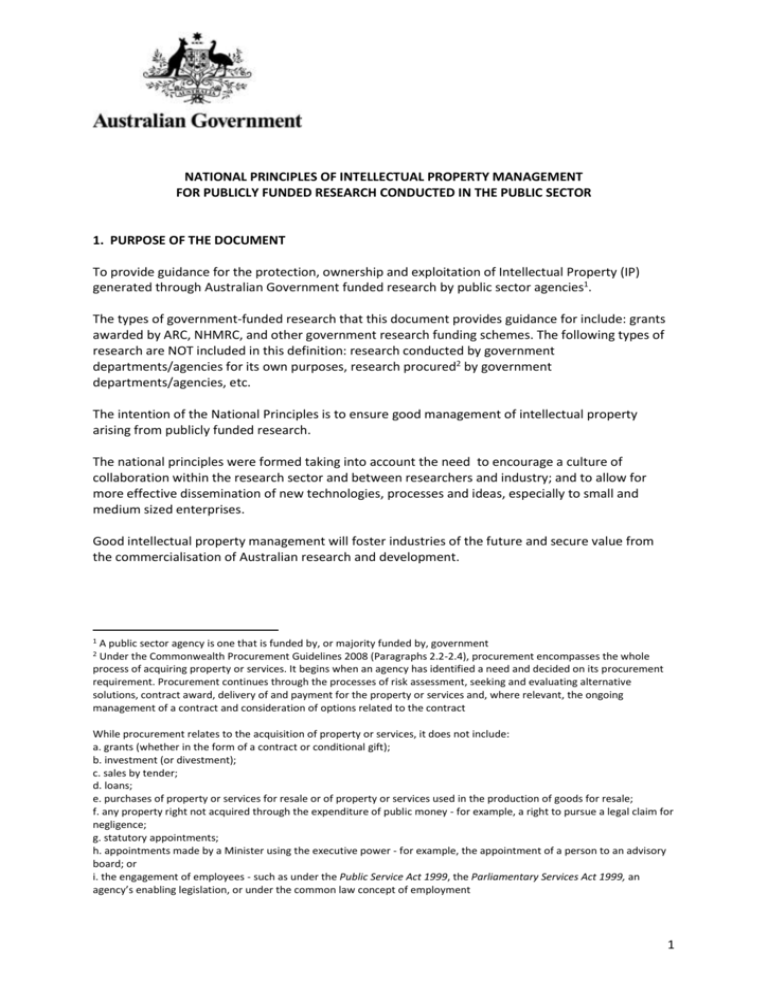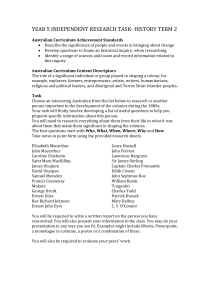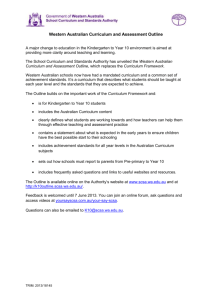National Principles of Intellectual Property Management
advertisement

NATIONAL PRINCIPLES OF INTELLECTUAL PROPERTY MANAGEMENT FOR PUBLICLY FUNDED RESEARCH CONDUCTED IN THE PUBLIC SECTOR 1. PURPOSE OF THE DOCUMENT To provide guidance for the protection, ownership and exploitation of Intellectual Property (IP) generated through Australian Government funded research by public sector agencies1. The types of government-funded research that this document provides guidance for include: grants awarded by ARC, NHMRC, and other government research funding schemes. The following types of research are NOT included in this definition: research conducted by government departments/agencies for its own purposes, research procured2 by government departments/agencies, etc. The intention of the National Principles is to ensure good management of intellectual property arising from publicly funded research. The national principles were formed taking into account the need to encourage a culture of collaboration within the research sector and between researchers and industry; and to allow for more effective dissemination of new technologies, processes and ideas, especially to small and medium sized enterprises. Good intellectual property management will foster industries of the future and secure value from the commercialisation of Australian research and development. 1 A public sector agency is one that is funded by, or majority funded by, government Under the Commonwealth Procurement Guidelines 2008 (Paragraphs 2.2-2.4), procurement encompasses the whole process of acquiring property or services. It begins when an agency has identified a need and decided on its procurement requirement. Procurement continues through the processes of risk assessment, seeking and evaluating alternative solutions, contract award, delivery of and payment for the property or services and, where relevant, the ongoing management of a contract and consideration of options related to the contract 2 While procurement relates to the acquisition of property or services, it does not include: a. grants (whether in the form of a contract or conditional gift); b. investment (or divestment); c. sales by tender; d. loans; e. purchases of property or services for resale or of property or services used in the production of goods for resale; f. any property right not acquired through the expenditure of public money - for example, a right to pursue a legal claim for negligence; g. statutory appointments; h. appointments made by a Minister using the executive power - for example, the appointment of a person to an advisory board; or i. the engagement of employees - such as under the Public Service Act 1999, the Parliamentary Services Act 1999, an agency’s enabling legislation, or under the common law concept of employment 1 2. PRINCIPLES AND POLICIES (a) The Australian Code for the Responsible Conduct of Research3 establishes an overall framework for responsible research practices in Australia. (b) Australian research institutions and researchers will make every reasonable effort to gain benefit for Australia from IP. This may involve protection or rapid placement in the public domain. (c) Ownership and the associated rights of all IP generated as a result of Australian Government competitively funded research will initially be vested in the research institutions administering the grants, recognising the Common Law rights of research institutions as employers. (d) Research institutions must have policies4, relating to the ownership, protection and exploitation of IP generated as a result of Australian Government competitive funding. These policies must: I. II. III. IV. V. VI. VII. VIII. IX. X. XI. XII. Be approved by the institution’s governing body; Ensure that there is clean and clear ownership of IP so as to maximise its chance of commercial exploitation; Make clear to all staff their responsibilities in relation to IP protection including, where appropriate, the maintenance of research records and the handling of research results prior to obtaining IP protection; Provide means to help researchers identify IP that should be protected and/or commercialised, and IP that would benefit innovation/the economy of Australia by being made freely available5; Recognise the rights and needs of all stakeholders involved in the research supported by public funds; Have agreements with employees and grant holders registered through the research institutions on ownership and/or associated rights of IP; Define the ways in which benefits from the development and exploitation of the IP will be allocated; Take into account the academic right to publish; Take into account the different circumstances for ownership of IP generated by students (including postgraduate students who are not covered under Common Law in this context) during their course of study, research and training; Have ways of addressing cases where IP impinges, or potentially impinges, on the cultural, spiritual or other aspects of indigenous peoples; Provide guidance in relation to potential conflicts of interest concerning ownership, management, protection and exploitation of IP; and Provide guidance on the licensing of copyright, in particular, the application of open access licences. 3 National Health and Medical Research Council, Australian Research Council, Universities Australia (2007) Australian Code for the Responsible Conduct of Research. Canberra http://www.nhmrc.gov.au/guidelines/publications/r39 4 These policies should be incorporated within the Australian code for the Responsible Conduct of Research requirements as set out in Part A, Chapter 1 “General Principles of Responsible Research” 5 Noting that some funding programs already have explicit IP requirements 2 (e) For Australia to reap the benefits of the IP, research institutions in receipt of research funding from the Australian Government must assist in the management of IP by providing: I. II. III. IV. V. VI. VII. Assistance to researchers in fulfilling their obligations and responsibilities6 as well as rewarding and encouraging their participation in any subsequent exploitation process; Support for researchers so that they can recognise when their discoveries may have potential commercial or other public value; Advice to the creators of the IP on the options available for commercialising the IP, or making the IP freely available; Regular reviews of IP development and associated commercial activities and outcomes arising from publicly funded research; Systems to support the management of the data from which the IP was derived in order to maximise the benefits from the research, including the documentation and safe storage for future use; Systems to record, manage and report on the IP held by that institution; Guidance to researchers in assessing existing IP in the field that is likely to affect their research in order to determine their freedom to operate in that field of research. (f) While not mandatory to the procurement of research by the Australian Government, the Principles outlined in this document, the Australian Code for the Responsible Conduct of Research, and the Statement of Intellectual Property Principles for Australian Government Agencies, may be usefully applied to the procurement process. It should include the rights of the academics to publish the results of the research. 3. ACCOUNTABILITY Research agencies in receipt of public funds for the purpose of conducting research must, if requested, assist in Government reporting activities to understand and document the IP arising from publicly funded research7. Signatories to this document: 6 7 For Example, the Australian Code for the Responsible Conduct of Research For example, the National Survey of Research Commercialisation 3







